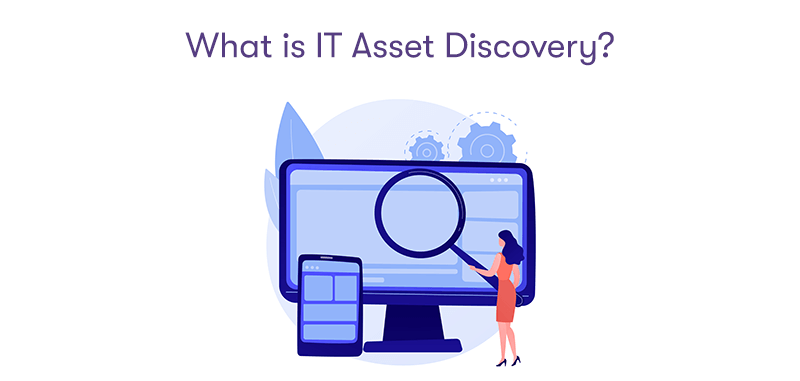What is IT Asset Discovery?
IT Asset Discovery is a process within the field of Information Technology (IT) management that involves identifying and cataloguing all the hardware and software assets within an organisation's network.
The process typically involves using specialised software tools that automatically scan the network to detect and record the details of each asset. These tools can provide detailed information such as each asset's type, model, operating system, installed software, and other pertinent information. Additionally, IT Asset Discovery is a continuous process, as the IT environment is dynamic, with assets constantly being added, removed, or updated.
What is IT Asset Discovery?
IT Asset Discovery is a systematic process used in the field of Information Technology to identify and document all IT assets within an organisation's network. This comprehensive procedure is integral for maintaining an accurate and up-to-date IT hardware, software, and other resources inventory. The process is typically automated, leveraging specialised tools and software, and can be augmented by manual methods in specific scenarios.
The process begins with the deployment of asset discovery tools. These tools scan the organisation's network to detect and identify all connected IT assets. This includes servers, workstations, network devices, storage systems, and connected peripherals. In addition to hardware, these tools also identify software assets, capturing details about installed applications, operating systems, and associated configurations. The discovery methods vary; some tools use agent-based technology, requiring software installation on each device, while others are agentless, remotely scanning the network without needing individual device installations.
Once the discovery tools identify the assets, they collect detailed information about each one. This data includes hardware specifications, software versions, configuration settings, and network data. This step is crucial as it goes beyond mere identification, delving into the specifics of each asset, which is necessary for effective management.
After data collection, the information is compiled into a centralised inventory or a configuration management database (CMDB). This inventory is a comprehensive repository of all IT assets within the organisation. It's not a static record; the inventory is updated to reflect these changes as assets are added, removed, or modified within the IT environment.
In summary, IT Asset Discovery is a dynamic and ongoing process that utilises a combination of automated tools and manual methods to continuously track and document the myriad of IT assets in an organisation. This process is fundamental for maintaining an accurate understanding of the IT infrastructure, which is essential for various IT management activities.
Why is IT Asset Discovery Important?
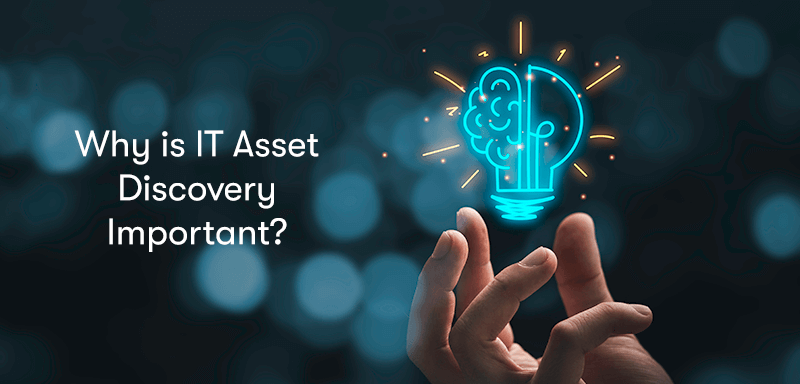
The importance of IT Asset Discovery in an organisation's IT infrastructure management is multi-dimensional, impacting various aspects of operations, security, compliance, and strategic planning. IT Asset Discovery is not just a technical necessity but a strategic business imperative. It enables organisations to maximise their IT investments, maintain security and compliance, and strategically plan for future growth and changes in the technology landscape. Let's delve into these aspects in more detail:
Operational Efficiency
Resource Optimisation: Knowing the exact inventory of IT assets helps optimise their use, ensuring that resources are not underutilised or wasted.
Maintenance and Upgrades: Regular discovery processes enable timely maintenance and upgrades of IT assets, reducing downtime and improving performance.
Security and Risk Management
Identifying Vulnerabilities: By keeping an up-to-date inventory of IT assets, organisations can quickly identify which devices are vulnerable or require security patches.
Preventing Unauthorised Access: Asset discovery helps detect unauthorised devices on the network, which could be potential entry points for security breaches.
Incident Response: In the event of a security incident, knowing the exact details of the affected assets can significantly speed up the response and mitigation process.
Compliance and Regulatory Requirements
Software License Compliance: Asset discovery ensures that all software in use is properly licensed, helping avoid legal and financial penalties associated with non-compliance.
Regulatory Compliance: Many regulations require strict control and visibility of certain types of data and the assets that process or store this data. Regular asset discovery helps maintain compliance with these regulations.
Cost Management and Financial Planning
Avoiding Unnecessary Expenditures: Organisations can avoid duplicate purchases and better plan for future investments with a clear view of all assets.
Asset Lifecycle Management: By understanding where each asset is in its lifecycle, companies can plan for replacements and budget accordingly, avoiding unexpected expenses.
Strategic IT Planning
Data-Driven Decisions: Asset discovery provides valuable data that can inform strategic IT decisions, such as infrastructure upgrades, expansions, or reductions.
Capacity Planning: Understanding current asset utilisation is crucial for effective capacity planning and ensuring that the IT infrastructure can meet future business demands.
Supporting Business Continuity and Disaster Recovery
Asset Redundancy: Knowing the critical assets and their redundancies helps in planning for business continuity and disaster recovery.
Recovery Prioritisation: In the event of a disaster, having an up-to-date asset inventory allows for prioritising the recovery of the most critical assets.
Enhancing IT Service Management (ITSM)
Asset-Related Incidents: A comprehensive asset database can help quickly resolve incidents related to specific IT assets.
Change Management: Understanding the current state of IT assets is essential for effective change management and minimising the impact of changes on business operations.
Supporting Remote and Hybrid Work Environments
Managing Distributed Assets: With the rise of remote and hybrid work models, IT Asset Discovery becomes even more crucial to managing and securing assets outside the traditional office environment.
How Does Asset Discovery Work in IT?
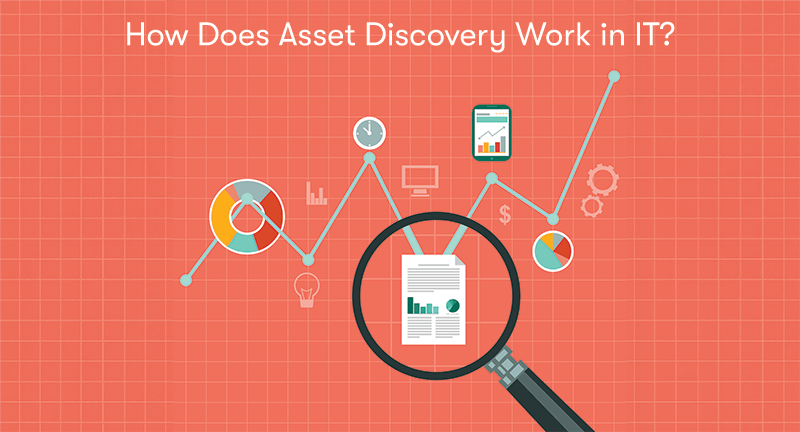
Asset Discovery in IT involves systematically identifying, cataloguing, and managing all IT assets within an organisation. This process typically includes the following steps:
1. Asset Identification
Scanning: The network is scanned using asset discovery tools. These tools can automatically detect devices connected to the network, such as servers, workstations, network devices, and peripherals.
Agents: In some cases, agents are installed on devices to collect detailed information about the hardware and software.
2. Data Collection
Hardware Data: Information about the hardware, like make, model, specifications, and physical location, is collected.
Software Data: Details about installed software, including versions, licenses, and configurations, are gathered.
Configuration Data: Network configurations, storage capacities, and other relevant settings are documented.
3. Inventory Creation
Cataloguing Assets: All collected data is catalogued in a centralised inventory management system. This inventory includes details of each asset, its status, and relevant metadata.
4. Data Analysis and Reporting
Asset Utilisation: The data is analysed to understand asset utilisation, identify redundancies, and detect underutilised resources.
Compliance Reporting: Reports are generated to ensure compliance with licensing agreements and regulatory requirements.
5. Maintenance and Monitoring
Regular Updates: The asset inventory is updated to reflect new, retired, or changed assets.
Monitoring Changes: Continuous monitoring for any changes in the IT environment, like new device connections or software installations.
6. Integration with Other IT Systems
IT Service Management (ITSM): Asset data is integrated with ITSM to manage IT services and support better.
Security Systems: Integration with security systems helps manage vulnerability and ensure network security.
7. Lifecycle Management
Lifecycle Tracking: Each asset is tracked throughout its lifecycle, from procurement to disposal.
Scheduled Maintenance: Planned maintenance activities are based on the lifecycle stage of the assets.
8. Supporting Business Functions
Strategic Planning: Asset data supports strategic IT planning, budgeting, and resource allocation.
Risk Management: Identifying and mitigating risks associated with IT assets.
9. Challenges and Best Practices
Dynamic Environments: Keeping up with changes in a dynamic IT environment.
Accuracy: Ensuring the accuracy and completeness of the inventory.
Best Practices: Implementing regular scans, maintaining up-to-date records, and integrating discovery tools with other IT management systems.
Asset Discovery vs Inventory Management - What's the Difference?
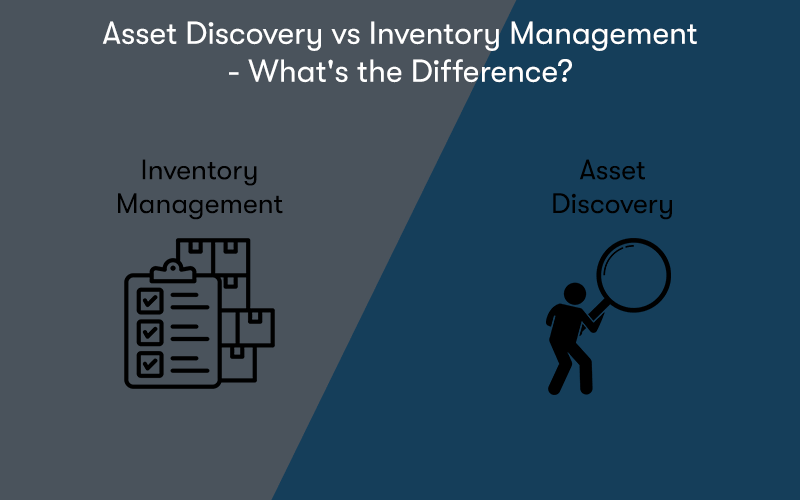
Asset Discovery and Inventory Management are two closely related but distinct processes in IT asset management. Understanding their differences is key to effectively managing IT resources. Here's a breakdown of each and how they differ:
Asset Discovery
Definition: Asset Discovery identifies and documents all the IT assets within an organisation's network. It involves the detection and listing of hardware and software assets.
Focus: The primary focus is locating and recognising all assets, including those that might be unaccounted for or unknown.
Methods: It typically uses automated tools that scan the network to detect devices and software. This can include both agent-based and agentless methods.
Scope: Discovery includes not only listing what exists but also gathering detailed information about each asset, such as type, model, operating system, installed software, configuration settings, etc.
Dynamic Nature: It is a continuous process, as the IT environment constantly changes with new devices being added, removed, or updated.
Purpose: The main goal is to ensure that every IT asset is accounted for, which aids in security, compliance, and operational efficiency.
Inventory Management
Definition: Inventory Management is the process of tracking and managing IT assets throughout their lifecycle. It involves organising, maintaining, and controlling the inventory of IT assets.
Focus: The focus is on managing assets after they are discovered. It involves overseeing the usage, performance, and maintenance of these assets.
Methods: This process involves tools for tracking the status, location, and condition of assets over time. It often requires integrating procurement, finance, and IT service management systems.
Scope: Inventory management deals with the quantification and valuation of assets, keeping track of their location, usage, and changes over time.
Strategic Management: It includes strategic aspects like planning for future asset needs, replacement schedules, and budgeting for IT resources.
Purpose: The goal is to optimise the utilisation and performance of IT assets, ensuring cost-effectiveness and supporting business objectives.
Key Differences of Asset Discovery & Inventory Management
Initial vs. Ongoing Process: Asset Discovery is about identifying what exists (an initial process), while Inventory Management tracks and manages those identified assets over time (an ongoing process).
Discovery vs. Management: Discovery is focused on detecting and listing assets, whereas Inventory Management is concerned with the strategic and operational management of these assets.
Scope of Information: Discovery gathers detailed information about the nature and specifications of assets, while Inventory Management focuses on the status, location, and lifecycle of assets.
While Asset Discovery and Inventory Management are integral parts of IT asset management, they serve different yet complementary purposes. Asset Discovery lays the groundwork by identifying and cataloguing assets, and Inventory Management builds upon this information to manage and optimise these assets effectively throughout their lifecycle. Together, they ensure a comprehensive approach to managing an organisation's IT resources.
Common Challenges with IT Asset Discovery
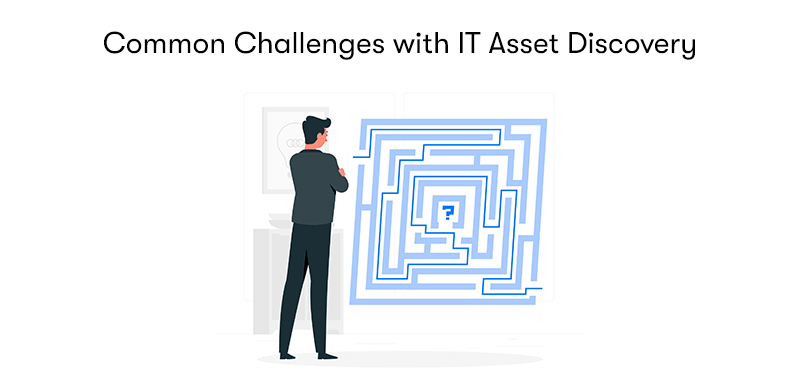
While essential for effective IT management, IT Asset Discovery comes with its own challenges. These challenges can vary in complexity and impact, depending on the size and nature of the organisation's IT infrastructure. Here are some common challenges associated with IT Asset Discovery:
Rapidly Changing IT Environments
Dynamic Networks: With frequent additions, removals, and updates of IT assets, keeping the asset inventory up-to-date can be difficult.
New Technologies: Integrating emerging technologies like cloud services, IoT devices, and mobile devices add complexity to the discovery process.
Incomplete or Inaccurate Data
Data Overload: The sheer volume of data collected can sometimes lead to information overload, making it hard to filter out relevant data.
Inconsistencies: Discrepancies between physical inventories and digital records can lead to inaccurate asset tracking.
Complexity of IT Infrastructure
Diverse Assets: Managing various assets, each with its own specifications and requirements, can be challenging.
Multiple Locations: Comprehensive discovery is more complex for organisations with assets spread across multiple locations or cloud environments.
Lack of Integration with Other Systems
Silos in IT Systems: Difficulty in integrating discovery tools with other IT management systems can hinder efficient asset management.
Data Synchronisation: Ensuring asset data is consistently updated across all systems is challenging.
Resource Constraints
Limited Resources: Smaller organisations may lack the necessary resources, like specialised tools or skilled personnel, for effective asset discovery.
Budget Constraints: Financial limitations can restrict the ability to invest in advanced discovery tools.
Security and Compliance Issues
Undetected Assets: Failing to detect all assets can leave blind spots in the network, increasing security risks.
Compliance Risks: Inadequate discovery processes can lead to non-compliance with software licensing, regulatory standards, and internal policies.
Technical Limitations of Discovery Tools
Coverage Limitations: Some tools may not be able to detect all types of assets, especially in complex networks.
Accuracy of Tools: The accuracy and reliability of discovery tools can vary, affecting the quality of the data collected.
Human Factors
User Error: Mistakes in manual entry or the configuration of discovery tools can lead to errors in the asset inventory.
Resistance to Change: Employees might be resistant to new processes and tools, hindering effective implementation.
Scaling Challenges
Growth Management: As organisations grow, efficiently scaling the asset discovery process to accommodate more assets can be challenging.
Navigating these challenges requires robust discovery tools, well-defined processes, skilled personnel, and continuous monitoring and updating of the asset inventory. Overcoming these challenges is crucial for maintaining an accurate and comprehensive understanding of the IT asset landscape, critical to effective IT management and security.
How Does IT Asset Discovery Work With ITAM?
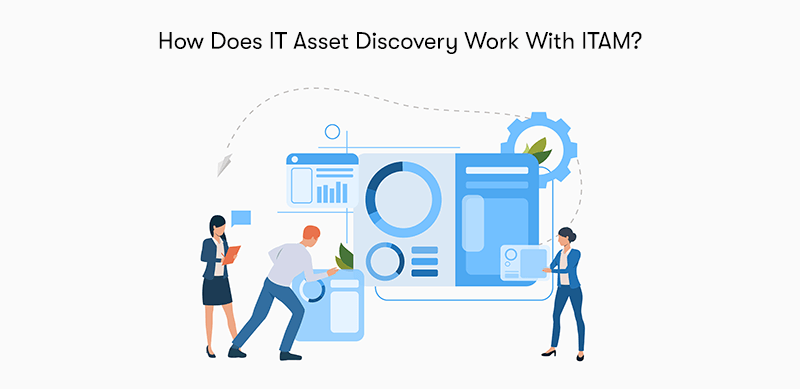
IT Asset Discovery is a critical component of IT Asset Management (ITAM), and the two are deeply interconnected. To understand how IT Asset Discovery works within the broader framework of ITAM, let's explore their relationship and integration:
Foundational Role in ITAM
Starting Point: IT Asset Discovery is the foundational step in ITAM by identifying an organisation's IT assets. ITAM cannot effectively manage what it doesn't know exists without a comprehensive discovery process.
Data Input: The detailed information gathered during the discovery process forms the primary dataset for ITAM.
Asset Inventory Creation
Cataloguing Assets: IT Asset Discovery helps create a detailed inventory of all hardware and software assets, a central element of ITAM.
Continual Updating: As assets are added, removed, or changed, the discovery process ensures that the ITAM database is continually updated.
Lifecycle Management
Tracking from Inception to Retirement: ITAM is concerned with managing the entire lifecycle of IT assets. Asset Discovery provides the initial data needed to track each asset's journey from procurement to disposal.
Maintenance and Upgrades: Information from the discovery process aids in scheduling maintenance and upgrades, which are integral to ITAM's role in managing asset health and performance.
Risk Management and Compliance
Identifying Unauthorised Assets: Discovery processes help identify unauthorised or non-compliant hardware and software, thereby managing risk and ensuring compliance.
Software License Management: Discovery tools help track software installations and usage, aid in compliance with licensing agreements, and avoid legal issues.
Cost Control and Optimisation
Avoiding Redundancies: By providing a clear view of all assets, discovery helps in identifying redundant or underutilised resources, allowing for cost optimisation.
Budgeting and Planning: The data from asset discovery informs budgeting for future IT expenditures, replacements, and upgrades.
Integration with Other IT Processes
IT Service Management (ITSM): Integration with ITSM processes like configuration management, incident management, and change management.
Security Management: Ensuring that all assets are accounted for and adequately secured is part of ITAM and security management strategies.
Supporting Strategic Decisions
Data-Driven Decisions: The comprehensive asset data provided by discovery processes supports strategic IT planning and decision-making within ITAM.
Challenges in Integration
Data Accuracy: Ensuring the data collected by asset discovery tools is accurate and reflective of the current state of IT assets.
Tool Integration: Integrating discovery tools with ITAM systems can sometimes be challenging due to compatibility or data synchronisation issues.
What is Considered an Asset in IT?
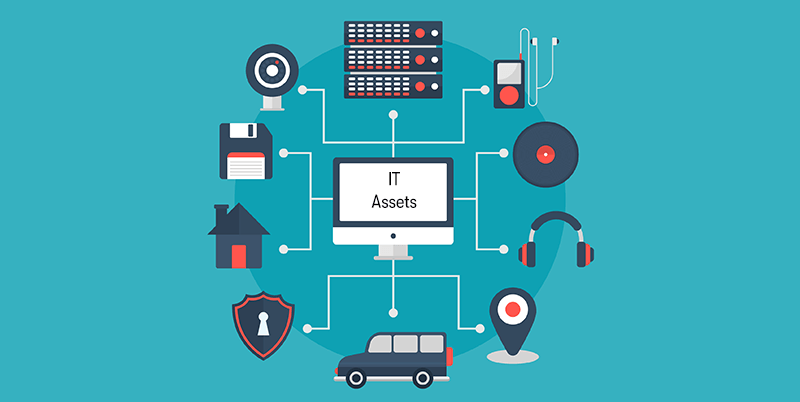
In IT, an asset is anything of value to the organisation and individuals. This encompasses a wide range of hardware, software, and informational entities. These assets are integral to the company's IT infrastructure and operations. Let's break down what is typically considered an asset in IT:
Hardware Assets
- Computing Devices: This includes desktop computers, laptops, servers, and workstations.
- Network Equipment: Routers, switches, firewalls, and other devices that support network connectivity and security.
- Storage Devices: Hard drives, solid-state drives, NAS (Network Attached Storage), and SAN (Storage Area Network) systems.
- Peripheral Devices: Printers, scanners, and other external devices connected to the network.
- Mobile Devices: Smartphones, tablets, and other portable devices used for business purposes.
- Data Centre Equipment: Equipment in data centres, including server racks, cooling systems, and backup power supplies.
Software Assets
- Operating Systems: Software that manages the hardware and provides standard services for computer programs.
- Applications: Business applications, productivity tools, database software, and any other software installed on company devices.
- Licensed Software: Software that requires a purchase or subscription, including commercial off-the-shelf (COTS) and software-as-a-service (SaaS) products.
- Custom Software: Software developed in-house or specifically for the organisation.
Digital Assets
- Data: Critical business data stored in databases, file systems, and backups.
- Intellectual Property: Proprietary algorithms, patents, trade secrets, and any other intellectual property developed by the organisation.
- Web Assets: Websites, domain names, and associated web services.
Cloud Assets
- Cloud Services: Services hosted in the cloud, such as SaaS, PaaS (Platform as a Service), and IaaS (Infrastructure as a Service).
- Virtual Machines: Virtualised environments hosted either on-premises or in the cloud.
Intangible Assets
- Software Licenses: Agreements that allow the organisation to use software products legally.
- Service Agreements: Agreements related to the maintenance and support of IT assets.
Final Notes on IT Asset Discovery
In conclusion, IT Asset Discovery stands as a cornerstone in the realm of IT management, underpinning effective infrastructure oversight. This process, integral for identifying, cataloguing, and managing IT resources, leverages automated tools and methodologies to scan and document all hardware and software assets within an organisation. By capturing detailed information, including hardware specifications, software versions, and configurations, IT Asset Discovery ensures that every asset is accounted for, aiding in operational efficiency, security, compliance, and strategic planning. As we have explored, this dynamic process is continuous, adapting to the ever-evolving IT landscape. Thus, IT Asset Discovery is not merely a task but a strategic imperative for organisations seeking to optimise their IT investments and mitigate risks, forming the bedrock of successful IT asset management.


